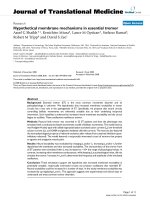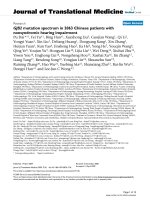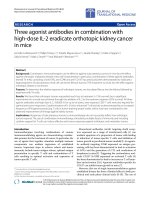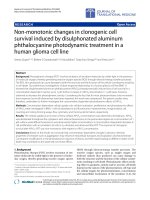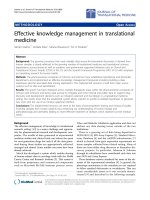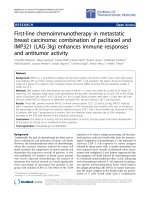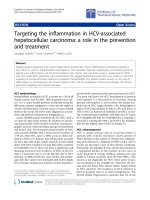Báo cáo hóa học: " Editorial Secure Steganography in Multimedia Content" pdf
Bạn đang xem bản rút gọn của tài liệu. Xem và tải ngay bản đầy đủ của tài liệu tại đây (413.28 KB, 1 trang )
Hindawi Publishing Corporation
EURASIP Journal on Information Security
Volume 2009, Article ID 257131, 1 page
doi:10.1155/2009/257131
Editorial
Secure Steganogr aphy in Multimedia Content
Miroslav Goljan
1
and Andreas Westfeld
2
1
Electrical and Computer Eng ineering, Watson School, Binghamton University, P. O. Box 6000, Binghamton, NY 13902-6000, USA
2
Faculty of Computer Science and Mathematics, HTW Dresden, Institute of Systems Architecture, University of Applied Sciences,
120701 PF, 01008 Dresden, Germany
Correspondence should be addressed to Miroslav Goljan,
Received 15 April 2009; Accepted 15 April 2009
Copyright © 2009 M. Goljan and A. Westfeld. This is an open access article distributed under the Creative Commons Attribution
License, which permits unrestr icted use, distribution, and reproduction in any medium, provided the original work is properly
cited.
Steganography, known as the art of covert communi-
cation, entered digital world about ten years ago. After
gaining special interest of research groups around the world,
steganography and steganalysis are slowly reaching maturity.
Images produced by digital cameras are typical multimedia
carriers where hiding secrets has been studied deeply. They
contain a large amount of randomness that is hard to
distinguish from telltale signs of hidden and eventually
encrypted messages.
The security requirement in steganography ultimately
means that no such detection method should exist that
wouldbeabletotellcarrierswithhiddenmessagesfrom
innocent ones with a significant reliability. Introduction of
every new steganographic scheme spurred a number of pub-
lications on steganalysis of that scheme. Empirically deter-
mined secure capacities shr ink with advances in steganalysis.
A hope for finding general optimal solutions is narrow
since they have to be tied to carrier models. To achieve
undetectability, steganographers minimize the impact of
message data embedding on the carrier in two ways, by
content-aware embedding in various transform domains and
by applying advanced coding techniques. While the first
is a kind of an art that needs to undergo the scrutiny of
steganalysis testing and validating, the second is much more
of a mathematical science. Theoretical bounds on coding
efficiency are known but hard to achieve in practical schemes.
Thus, secure steganographic capacity is difficult to determine
for multimedia carriers and remains to be an open issue.
We are delighted to present five papers devoted to
the above mentioned aspects of steganography and its
counterpart, steganalysis. Fontaine and Galand prove the
power of established structured codes in “How can Reed-
Solomon codes improve steganographic schemes.” While
syndrome coding in steganographic schemes tends to reduce
distortion during embedding, Miche et al. in “Reliable
Steganalysis Using a Minimum Set of Samples and Features”
push sensitivity of universal steganalysis a step further
and reduce secure capacities of any steganography a bit.
“Steganography in 3D Geometries and Images by Adjacent
Bin Mapping” presented by Wu and Dugelay introduces a
new countermeasure to steganography detection through
histogram characteristic function.
JPEG compression format for images became the one
that attracts steganographers the most. Rossi, Garzia,
and Cusani return to the topic with “Peak-Shaped-Based
Steganographic Technique for JPEG Images.” Their novel
model-based steganographic technique for JPEG images
involves heur istic assumptions about the shape of the DCT
frequency histograms, and finally, both aspects—coding and
embedding operation—are merged in the design of a new
scheme by Chao et al. described in “A Novel Image Data
Hiding Scheme with Diamond Encoding.”
Our thanks belong to the authors and to all reviewers for
their contribution to this journal. We hope that readers will
find the papers interesting at least and that blank pages in
steganography area will continue being filled.
Miroslav Goljan
Andreas West f eld

